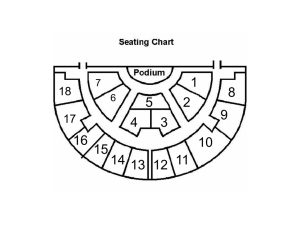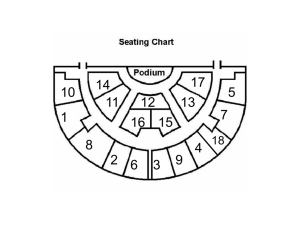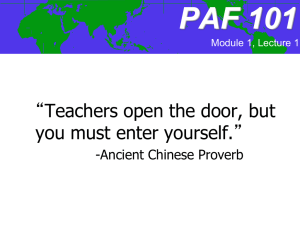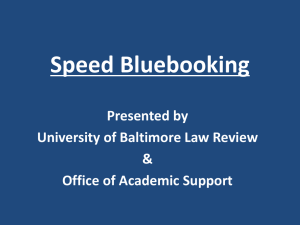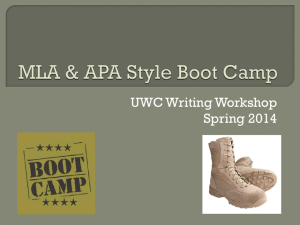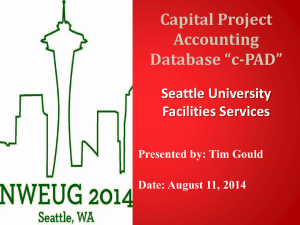Module 2 - Content URL
advertisement
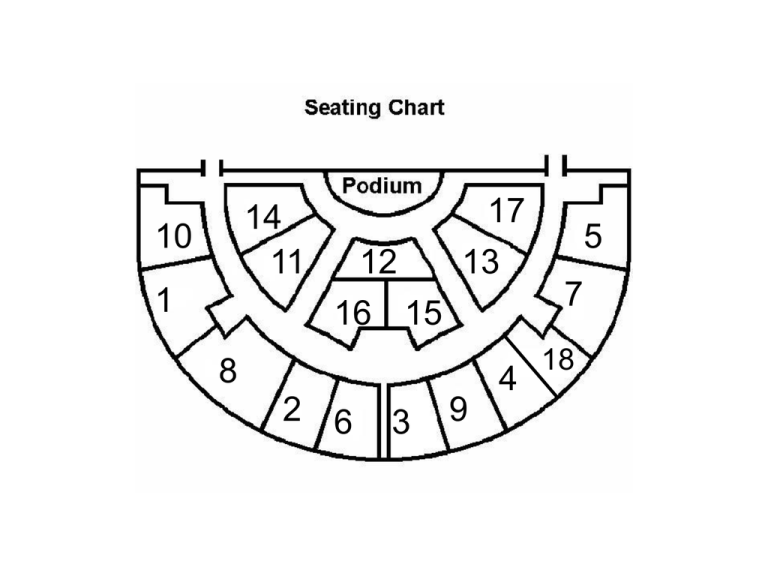
14
11
10
1
12
16 15
17
13
7
8
2 6
3
5
9
4
18
PAF 101
Module 2, Lecture 2
“An educated person is one who has
learned that information almost always
turns out to be at best incomplete and
very often false, misleading, fictitious--just dead wrong.”
~ Russell Baker
Class Agenda
Announcements
Quick Introduction to Module 2
Basic Training in Library Research
Assignment for Next Class
Competition Points
Winners
Losers
As of 2/2/2015
Group #
Points
12
6
4
5
6
5
15
5
9
4
14
4
1
3
2
3
3
3
7
3
8
3
10
3
11
3
13
3
17
3
18
3
16
3
5
0
Introduction to Module Two
Exercises for Chapters 2-4
One of Seven Topic
Areas from Module 1
Not Too Specific
Introduction to Module Two
Chapter 2: use the library
Chapter 3: research players
Chapter 4: design a survey on a societal
problem or policy in a specified
geographical area
PAF 101
Module 2: The Academic Library
Michael Pasqualoni –
Public Affairs & Political Science Librarian
mjpasqua@syr.edu (315) 443-3715
PAF 101
Module 2: The Academic Library
Overview of Module 2
Crucial SU Libraries resources for Module 2
Important locations @ SU Libraries
Advice on specific Module 2 exercises
PAF 101
Module 2 Conceptual Overview:
Incorporates
Multiple information formats &
retrieval tools
Requires significant time investment, due 2/20
Increases familiarity & comfort level with use of a
research library
Calls for navigating a series of research exercises
where attention to detail is essential
Crucial SU Libraries Resources for Module 2
Off-campus access to subscription
databases and electronic journals –
etc. –use your:
SU NETID/NETID Password
SU Libraries
Offline & Online
visit: http://library.syr.edu/about/locations/
for info about library building hours, etc.
Four Primary Branches
(and Belfer Audio Lab and Archive)
50+ librarians/Close to 200 staff members
Over 3 million monographs & other print backfiles
Over 1 million audiovisual titles
Over 49,000 serial/periodical subscriptions
Nearly 1000 electronic databases
Carnegie Library
Silent reading & study area
Computer cluster available
Sept 11, 1907: Original Carnegie Library opens
{was SU’s main library until Bird Library opened in 1972}
Collections – in addition to the sciences, engineering, health and math, now
also includes books in photography and military sciences
Bird Library = shelving location
for books covering all Maxwell
School disciplines (incl PAF 101)
-lesser used titles & print versions of many periodicals and academic journals shelved
in high density storage (aka: SU Libraries “Facility”)
– request forms appear on library catalog item record pages for books or periodicals
located at the “facility” (next business day delivery Sunday thru Friday with articles
delivered by email; books physically delivered to Bird Library’s 1st floor circulation
desk)
-vast majority of the collection’s periodicals, newspapers, journal articles, etc.
available online, 24/7, via the library web site link labeled “journals”
(and via 100s of licensed databases)
Library Services
•Your SU ID Card = Your Library Card
(undergraduate student borrowing period for books is
28 days) – see ‘your accounts’ link @ library website for
information about books you have checked out,
to renew books, etc.
TEAM ROOMS WITH TECHNOLOGY
AT BIRD LIBRARY..reserve in person at 1st floor
technology desk OR via “study spaces” link at
library.syr.edu
Question by Question Guidance – the database
tools you’ll use on Module 2:
2.1 –
Note the option
to zoom into
sets of data
tables extracted
from many of
these full
statistical
report PDFs
Options for
sorting, refining
and narrowing
results appear at
left margin (or
right margin) in
many databases
2.1 –
A “Retrieved
from…”
database URL
NOT required
in your APA
citation
for this
subscription
database/
Listing a DOI –
“Digital Object
Identifier” also
not required.
Example of APA Style Citation (Module 2 – Exercise 2.1)
– for List of References
Bureau of Transportation Statistics (Department of Transportation) (2014). Estimated National Emissions of
Sulfur Dioxide [By Source, Selected Years, 1970-2013] (Page no. 302 Table no. 210). [Data file]. Retrieved
from ProQuest Statistical Insight database
– In text citation
(Bureau of Transportation Statistics, 2014)
2.2 –
ProQuest
…also used for Exercise 4.5
Select desired
date range.
Article (for Ex.
2.2) must have
been published
in past 6 months!
Use “Source
Type” menu for
limiting results to
magazines or
newspapers.
A “Retrieved
from…” database
URL NOT
required
in your APA
citation
for this
subscription
database/
Listing a DOI –
“Digital Object
Identifier” also
not required.
Example of APA Style Citation (Module 2 – Exercise 2.2)
– for List of References
Peltz, J. (2014, April 17). Bloomberg plans $50M gun control network. The Charleston Gazette,
p. A.10. Retrieved from ProQuest database
– In text citation (if quoting or paraphrasing from this specific page)
(Peltz, 2014, p. A.10)
2.3 –
“SUMMON”
search engine
library.syr.edu
Use “advanced
search” for
greater control
over search results
Book (for Ex. 2.3) must have been published
in past 15 years!
2.3
http://library.syr.edu/help/summon
2.3
Reminder:
Do not use
an ebook for
this exercise.
2.3
2.3
Example of APA Style Citation (Module 2 – Exercise 2.3)
– for List of References
Pedroni, T.C. (2007). Market movements: African American involvement in
school voucher reform. New York: Routledge.
– In text citation (if quoting or paraphrasing from specific page range)
(Pedroni, 2007, pp. 100-101)
Note:
Citation
formatting
is
different if
you are
quoting
from a
separately
authored
chapter
within an
edited
book.
See the
PAF 101
Module 2
APA
Guide for
further
guidance
2.4 – Catalog of U.S.
Government Publications
http://catalog.gpo.gov
2.4 –
Citing U.S.
government
publications can be
very challenging
because no single
standard exists
Example of APA Style Citation (Module 2 – Exercise 2.4)
– for List of References
Ending the school-to-prison pipeline. U.S. Senate, Committee on the
Judiciary. (2014). Hearing, December 12, 2012, Washington: U.S.
Government Printing Office.
– In text citation
(Ending the school-to-prison pipeline, 2014)
*also indicate pp. numbers if doing a direct quotation or paraphrase
2.4 – Citing U.S. Government Publications –
Additional Citation Formatting Examples
Lawyers and law students often refer to the “Bluebook: A Uniform System of Citation”;
less helpful for those working outside that legal context
The Debora Cheney reference book (below) is helpful, but the older publication date means
it will be weaker in guidance for government publications located online
In addition to PAF 101’s MOD 2 APA Guide (via Penn State U.) - for more examples of U.S. Government
Publication citation formatting – consider:
Cheney, D. (2002). The complete guide to citing government information resources. Bethesda, MD:
LexisNexis, Congressional Information Service {J 9.5 G37 2002, Bird Library – 3rd Floor – Government
Reference (does not circulate)}
Brief Guide to Citing Government Publications. University Libraries, University of Memphis
http://www.memphis.edu/govpub/citweb.php (excellent!...except beware their example for citing
publications with Congress as author (such as a U.S. Senate or U.S. House hearing) strays from the norm.
If citing such hearings, examples on the previous and subsequent slides are preferred!
Citing Government Publications. Syracuse University Libraries Subject Guide
http://researchguides.library.syr.edu/content.php?pid=43416&sid=320357
2.4 – Citing U.S. Government Publications –
Examples of variation when citing Congress vs. a non-Congressional agency
If a U.S. Senate (or U.S. House) hearing is what you cite, notice that the title of the hearing is
listed first, where normally a personal or organizational author would be listed:
– for List of References
Ending the school-to-prison pipeline. U.S. Senate, Committee on the Judiciary. (2014). Hearing, December
12, 2012, Washington: U.S. Government Printing Office.
– In text citation
(Ending the school-to-prison pipeline, 2014)
*also indicate pp. numbers if doing a direct quotation or paraphrase
By contrast, the example you see at the PAF 101 APA guide via Penn State – for a situation
where one is citing a report from a non-Congressional U.S. government agency - lists the
name of the issuing agency as an organizational author:
– for List of References
U.S. Dept. of Housing and Urban Development. (2000). Breaking the cycle of domestic violence: Know the
facts. Washington, DC: U.S. Government Printing Office.
– In text citation
(U.S. Dept. of Housing and Urban Development, 2000)
*also indicate pp. numbers if doing a direct quotation or paraphrase
2.5– U.S. Census Data
http://www.census.gov
“QuickFacts” will help
you locate data needed
for this exercise.
http://quickfacts.census.gov
When viewing ‘quick
fact’ data for your home
state (& home town,
city or county) – visit
the tab called “USA
QuickFacts” for
national data.
2.5– U.S. Census Data
http://www.census.gov
Within “QuickFacts,” the “Selection Map”
for each state’s counties can help you
locate a comparably sized area to your
home town/city/county.
Keeping Track of Sources/APA Citation Style–
PAF 101 Web Site
For Next Class
1. Choose topic and get exercises 2.12.3 done by Wednesday
2. Aim to finish 2.1-2.6 by next Monday
3. Start reading chapters 3 and 4
4. Complete and bring in prospective
community service form by 2/13 or
lose 5 points
http://classes.maxwell.syr.edu/paf101

